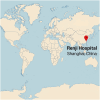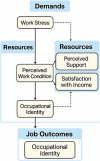Resilience and professional identity among young healthcare workers in a Shanghai megahospital during COVID-19: a cross-sectional study
- PMID: 40746684
- PMCID: PMC12310684
- DOI: 10.3389/fpubh.2025.1632053
Resilience and professional identity among young healthcare workers in a Shanghai megahospital during COVID-19: a cross-sectional study
Abstract
Background: Public health crises such as the COVID-19 pandemic place immense psychological and professional pressure on healthcare workers, particularly those early in their careers. While much research has focused on burnout and stress, fewer studies have examined the role of professional identity and its organizational determinants among actively employed young healthcare professionals.
Methods: This cross-sectional study surveyed 326 young healthcare workers (≤40 years old) across clinical, research, and administrative roles in a megahospital in Shanghai, China. A validated multidimensional scale was used to assess professional identity. Independent variables included job satisfaction, workload, exposure to high-risk duties, and perceived organizational support (including satisfaction with humanistic care and working conditions). Descriptive statistics, Mann-Whitney U and Kruskal-Wallis H tests, and multivariate linear regression were employed.
Results: The majority of respondents (92.9%) reported a high level of professional identity (median score: 81, IQR: 13). Satisfaction with humanistic care (B = 3.431, p = 0.009) and working conditions (B = 3.679, p = 0.003) were strong predictors of higher professional identity scores. Significant differences in professional identity were observed based on gender, income satisfaction, and exposure to COVID-19 patients.
Conclusion: This study highlights the essential role of organizational resources-particularly perceived humanistic care and adequate working conditions-in sustaining professional identity among young healthcare professionals during public health emergencies. The findings underscore the need for system-level interventions that support resilience and workforce stability. These insights may inform global strategies for healthcare human resource management in high-pressure contexts.
Keywords: COVID-19; humanistic care; organizational resources; professional identity; public health emergency; working conditions; young healthcare workers.
Copyright © 2025 Xu, Zhou, Yan, Wang, Le, Ma, Wang and Zhou.
Conflict of interest statement
The authors declare that the research was conducted in the absence of any commercial or financial relationships that could be construed as a potential conflict of interest.
Figures




Similar articles
-
A model of occupational stress to assess impact of COVID-19 on critical care and redeployed nurses: a mixed-methods study.Health Soc Care Deliv Res. 2024 Dec;13(23):1-32. doi: 10.3310/PWRT8714. Health Soc Care Deliv Res. 2024. PMID: 39708055
-
Resilience and the Dynamics of Job Demands: A Diary Study on Interactions in Healthcare Professionals During the COVID-19 Pandemic.J Adv Nurs. 2025 Aug;81(8):4698-4711. doi: 10.1111/jan.16629. Epub 2024 Nov 21. J Adv Nurs. 2025. PMID: 39569907 Free PMC article.
-
Burnout and resilience among intensive care workers facing the end of the COVID-19 pandemic: a cross-sectional study.Sao Paulo Med J. 2025 Aug 11;143(5):e2024244. doi: 10.1590/1516-3180.2024.0244.R1.07032025. eCollection 2025. Sao Paulo Med J. 2025. PMID: 40802424 Free PMC article.
-
Measures implemented in the school setting to contain the COVID-19 pandemic.Cochrane Database Syst Rev. 2022 Jan 17;1(1):CD015029. doi: 10.1002/14651858.CD015029. Cochrane Database Syst Rev. 2022. Update in: Cochrane Database Syst Rev. 2024 May 2;5:CD015029. doi: 10.1002/14651858.CD015029.pub2. PMID: 35037252 Free PMC article. Updated.
-
Job satisfaction and burnout syndrome among intensive-care unit nurses: A systematic review and meta-analysis.Intensive Crit Care Nurs. 2024 Jun;82:103660. doi: 10.1016/j.iccn.2024.103660. Epub 2024 Feb 22. Intensive Crit Care Nurs. 2024. PMID: 38394983
References
MeSH terms
LinkOut - more resources
Full Text Sources
Medical

